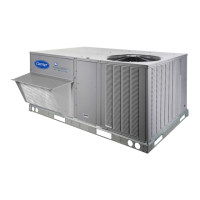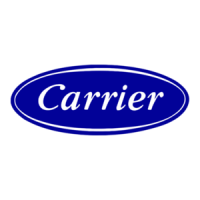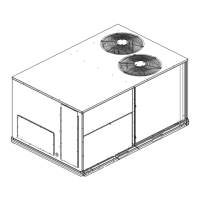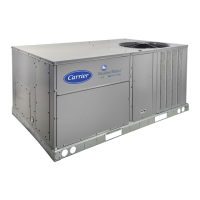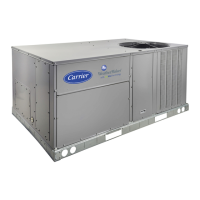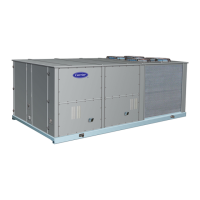22
Stage Increase Time (HEAT STAGEUP TIME) has to expire and
the Supply--Air Trend (SUPPLY AIR TREND) has to be above
the Heating supply air trend level (HEAT S ATTREND LEV)
before another stage can be added. Requested stages will only be
allowed to increase as the actual system demand allows
(DEMAND). A “LOW HEAT” will only allow one requested stage
and “HIGH HEAT” 2 stages. The requested stages will be reduced
if the heating demand is lowered or dropped completely, or if the
supply air falls below the lower level (LOWER MIN SAT).
Traditional Thermostat Control
Stage timers and Supply air trend do not apply when determining
the request for stages. Request staging will follow the thermostat
inputs directly. “LOW HEAT” will request one stage. “HIGH
HEAT” will request 2 stages.
Heat Relay Control
The heat relay control i s responsible f or energizing or de--ene rgizing
the hea t st age relays a nd wor ks hand and hand with the staging
control. As the staging control requests stages, the hea t rel ay c ont rol
determines what actual heat relays are available or ener gized and tries
to provide stages for what is requested. The availability of heat relays
depends on t he he at installed, how many st ages , and time guar ds . The
Number of Heat Stages (HEATING ST AGE QTY) configuration tells
the control how ma ny hea t re lays ca n be used. Heat Stage 1Timegua r d
(HEAT 1 TIMEGUARD) and Heat Stage 2 Timeguard (HEA T 2
TIMEGUARD) display the time a respective heat relay has before it
can cha nge st ate. The available st ages a t any given ti m e ar e dis pl ayed
as heat 1 available and heat 2 availabl e (HEAT 1 AVAILABLE and
HEAT 2 AVAILABLE) . The actual heat relays on at any given time
are displayed as Actual Heating Stages (ACTVE HEA T STAGE).
Heat Stage 1 Relay (HEAT 1 RELAY) and Heat Stage 2 Relay
(HEAT 2 RELA Y) are displayed on when the respective relay is
energized. There are ti m e guards to protect f rom s hor t cycling, Heat
Minimum On Ti me (HEAT MIN ON) and Heat Minimum Off Time
(HEAT MIN OFF) apply before a heat relay can be turned back on
or turned off.
Integrated Gas Controller (IGC)
The heat st aging is determine d as des cribed above and the Integrated
Gas Controller (IGC) initiates the gas heat module st art--up. The
Integrated Gas Controller (IGC) minimum on--time of 1 minute will
be followe d e ven if Heat Minimum On T ime (HEAT MI N ON) is
lower and during Service T est. If the IGC temperature limit switch
opens within 10 minut es of the end of the gas hea t cycle, the next fa n
off delay wi l l be extended by 15 seconds. The maxi m um delay is 3
mi nut es. Once modified by the IGC, the fa n of f del ay wi l l not change
back to the configured Fan--off Delay, Gas Heat (HEAT FANOFF
DELAY) unless power is reset to the control. A light emitting diode
(LED) is provided on the IGC to indi cate st atus. During norm al
operation the LED is cont inuously on. See the Troubleshooting
section if the LED is off or flashing. The IGC is located behind the
gas section access panel door.
When the control energizes Heat Stage 1 Relay (H EAT 1 RELAY),
power is sent to the W terminal on the IGC board. A check is made to
ensure that the rollout switch and limit switch are closed. The
induced--draft motor is then energized, and when speed is proven with
the Flue Gas Pressure switch, the ignition activation period begins.
The burners will igni te within 5 seconds. If the burne rs do not li ght,
there is a 22--second delay be f ore a nother 5--s e cond at tem pt. If t he
burners still do not light, this sequence is repeated for 15 minutes.
After the 15 minutes have elapsed, if the burners still have not lit,
heating is locked out. The c ont rol will re set when the request for he at
is temporarily removed. When ignition occurs the IGC board will
continue to monitor the condition of the rollout switch, limit switches,
the Flue Gas Pressure switch, as well as the flame sensor. If the unit is
controll ed through a room thermost at or spa ce sensor set for aut o--fan,
45 seconds af t er ignition occurs the indoor--fan motor wil l be
ener gi zed (a nd t he outdoor--air dam pers will open to thei r mi ni m um
position) . If for some re ason the over te mperature li m it opens pri or to
the st art of the indoor fa n blow er, on the next at t empt, the 45--se cond
delay will be shor t ened to 5 se conds less than the ti m e from initiation
of heat to when the limit tripped. Gas will not be interrupted to the
burners and heating wil l cont inue. Once modified, t he fan on delay
will not change bac k to 45 seconds unless powe r is reset to t he
control. When the control energizes Heat Stage 2 Relay (HEAT 2
RELAY), power i s s uppl ied to the s econd st age of the main gas val ve.
If both st age 1 and st age 2 of the gas valve cl ose, gas will be turned
off to t he ma i n burners.
Supply Air Tempering
Supply Air Tempering control operates the gas or electric heat to
maintain a minimum supply air temperature during conditions
where very cold outdoor air causes the supply air temperature to
fall below the configured Supply Air Tempering Setpoint. This
occurs during periods where DCV is active and increasing the
amount of outdoor air or in cases where the system is operating at
very low airflow and the calculated economizer position has
increased to maintain a constant ventilation rate.
The user can enable/disable Supply Air Tempering.
The following conditions must be true for the supply air tempering
algorithm to operate:
S The SA Tempe r ing is set to Yes (OKTOSATEMPER=YES)
S The indoor fan is on
S The System Mode is in Vent (Ventilation or Supply Fan Only) or
IAQ Override.
S The Outdoor Air Temperature < Minimum Cooling SAT 48_F.
S Heat type is gas or electric and Number Of Heat Stages > 0
If all the above are true, the SystemVut controller will monitor the
SAT sensor value and operate the first stage of heat to temper the
supply air as required in order to maintain the configured SA
Tempering Setpoint.
Two Position Damper O peration
The Two Position damper is used for ventilation. If the indoor fan
is not on the two position damper will not open. If the two position
damper is installed then ventilation method will be set to two
position damper (VENT METHOD = 2POS DMPER (2)), and
two position damper channel will be configured (2POS/ERV
CHANNEL). When the unit is occupied and the indoor fan is
running, the two position damper configured relay will energized.
This then activated the motor at the damper to open to the
mechanical stop position enforced at the actuator. This will provide
the customer set ventilation rate determine for the space.
NOTE: If two position damper is installed with a multiple speed
system, the ventilation rate will be high or low depending on the
specific speed running during set up and the current speed being
run for normal operation.
Economizer Operation
The Economizer is used for ventilation, and cooling. If the Indoor
fan is not on, the economizer will not operate. If an economizer is
installed, then Vent Method (VENT METHOD = ECON) should
be set to economizer. The unit produces a 4--20mA signal which is
then changed to a 2 --10V signal with a 500 ohm resistor, which can
control the economizer actuator. The economizer output signal is
displayed by the Economizer Commanded Position (ECON CMD
POSITION). The actuator’s built-- in 2 to 10VDC feedback signal
is read in as an analog input to know the actual position which is
displayed as Economizer Actual Position (ECON ACT
POSITION).
Minimum Ventilation
The economizer will open to allow ventilation when the indoor fan
is turned on and the unit is in the occupied state. The economizer
damper position at any given time for ventilation is displayed as
the Min Position in Effect (EFFECTIVE MIN POS).This
minimum position can be effected by the indoor fan speed (F.SPD)
and indoor air quality. T o maintain a constant airflow through the
economizer, as the indoor fan speed decreases or increases the

